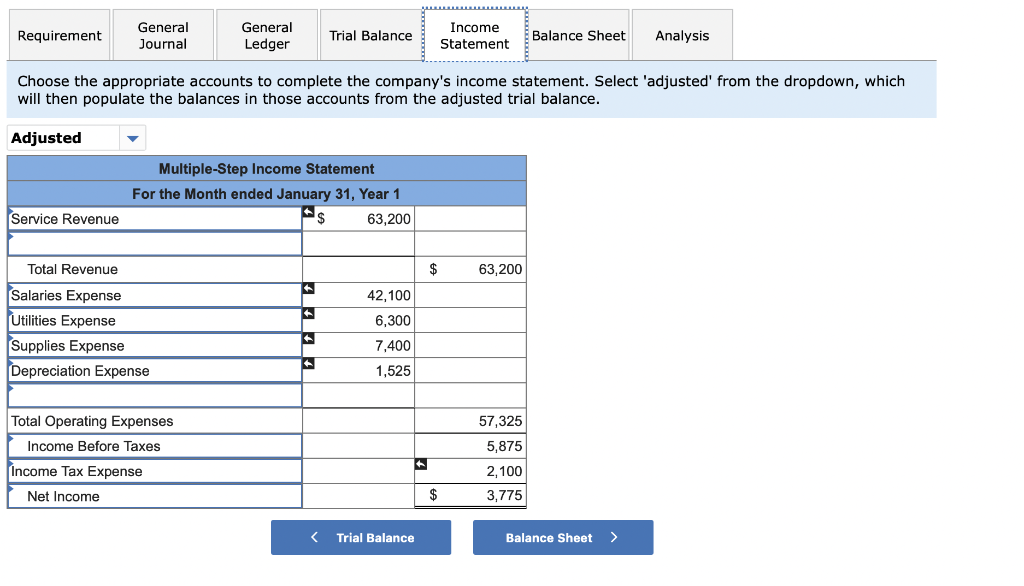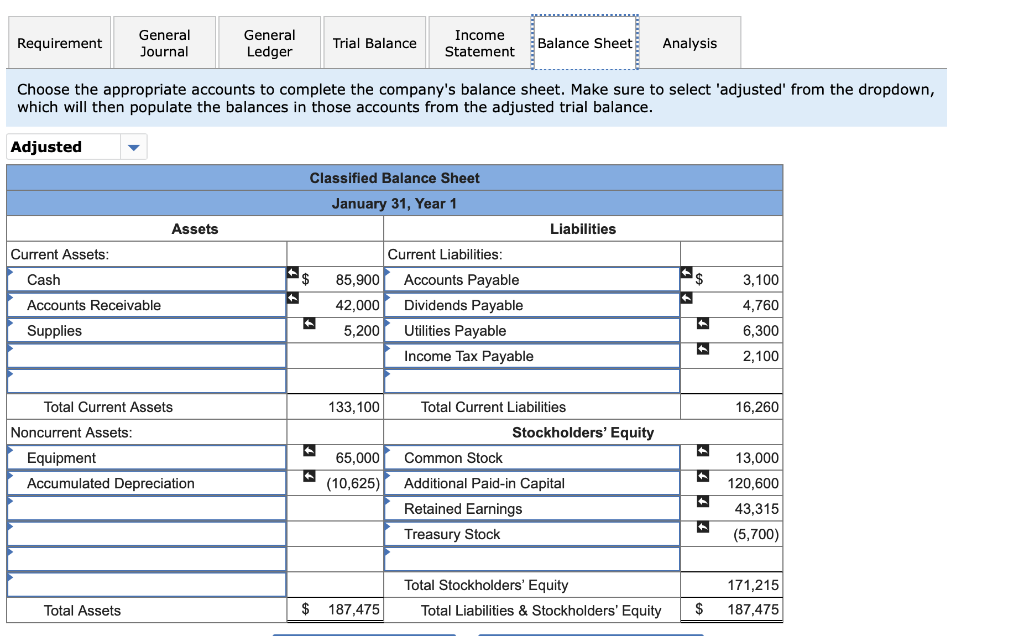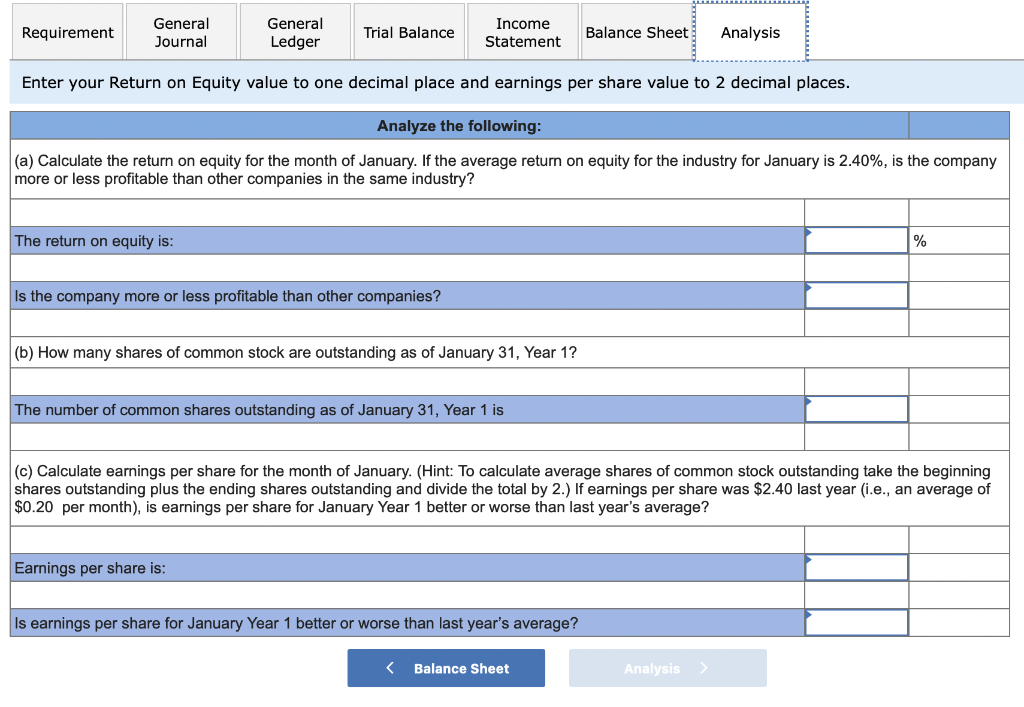8. Analyze the following:




Requirement General Journal General Ledger Trial Balance Income Statement Balance Sheet Analysis Choose the appropriate accounts to complete the company's income statement. Select 'adjusted' from the dropdown, which will then populate the balances in those accounts from the adjusted trial balance. Adjusted Multiple-Step Income Statement For the Month ended January 31, Year 1 $ 63,200 Service Revenue Total Revenue $ 63,200 Salaries Expense Utilities Expense Supplies Expense Depreciation Expense 42,100 6,300 7,400 1,525 57,325 Total Operating Expenses Income Before Taxes Income Tax Expense 5,875 2,100 3,775 Net Income $ Requirement General Journal General Ledger Trial Balance Income Statement Balance Sheet Analysis Choose the appropriate accounts to complete the company's balance sheet. Make sure to select 'adjusted' from the dropdown, which will then populate the balances in those accounts from the adjusted trial balance. Adjusted Classified Balance Sheet January 31, Year 1 Assets Liabilities Current Assets: Current Liabilities: Cash $ 85,900 42,000 Accounts Receivable Supplies Accounts Payable Dividends Payable Utilities Payable Income Tax Payable 3,100 4,760 6,300 2,100 5,200 133, 100 16,260 Total Current Assets Noncurrent Assets: Equipment Accumulated Depreciation 13,000 65,000 (10,625) Total Current Liabilities Stockholders' Equity Common Stock Additional Paid-in Capital Retained Earnings Treasury Stock 120,600 43,315 (5,700) Total Stockholders' Equity Total Liabilities & Stockholders' Equity 171,215 187,475 Total Assets $ 187,475 $ On January 1, Year 1, the general ledger of a company includes the following account balances: Accounts Cash Accounts Receivable Supplies Equipment Accumulated Depreciation Accounts Payable Common Stock, $1 par value Additional Paid-in Capital Retained Earnings Totals Debit Credit $ 42,800 44,700 7,600 65,000 $ 9, 100 14,700 11,000 81,000 44,300 $160,100 $160, 100 During January Year 1, the following transactions occur: January 2 Issue an additional 2,000 shares of $1 par value common stock for $40,000. January 9 Provide services to customers on account, $14,000. January 10 Purchase additional supplies on account, $5,000. January 12 Purchase 1,100 shares of treasury stock for $19 per share. January 15 Pay cash on accounts payable, $16,600. January 21 Provide services to customers for cash, $49,200. January 22 Receive cash on accounts receivable, $16,700. January 29 Declare a cash dividend of $0.40 per share to all shares outstanding on January 29. The dividend is payable on February 15. (Hint: The company had 11,000 shares outstanding on January 1, Year 1, and dividends are not paid on treasury stock.) January 30 Resell 800 shares of treasury stock for $21 per share. January 31 Pay cash for salaries during January, $42, 100. The following information is available on January 31, Year 1. a. Unpaid utilities for the month of January are $6,300. b. Supplies at the end of January total $5,200. C. Depreciation on the equipment for the month of January is calculated using the straightline method. At the time the equipment was purchased, the company estimated a service life of three years and a residual value of $10,100. d. Accrued income taxes at the end of January are $2,100. Requirement General Journal General Ledger Trial Balance Income Statement Balance Sheet Analysis Enter your Return on Equity value to one decimal place and earnings per share value to 2 decimal places. Analyze the following: (a) Calculate the return on equity for the month of January. If the average return on equity for the industry for January is 2.40%, is the company more or less profitable than other companies in the same industry? The return on equity is: % Is the company more or less profitable than other companies? (b) How many shares of common stock are outstanding as of January 31, Year 1? The number of common shares outstanding as of January 31, Year 1 is (c) Calculate earnings per share for the month of January. (Hint: To calculate average shares of common stock outstanding take the beginning shares outstanding plus the ending shares outstanding and divide the total by 2.) If earnings per share was $2.40 last year (i.e., an average of $0.20 per month), is earnings per share for January Year 1 better or worse than last year's average? Earnings per share is: Is earnings per share for January Year 1 better or worse than last year's average?










